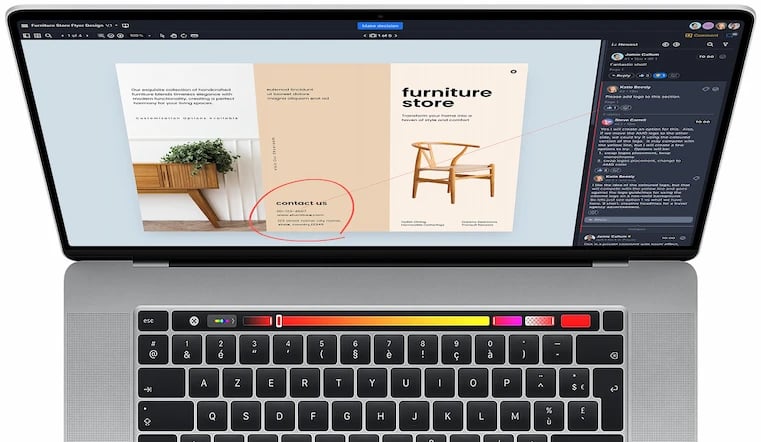Ed Catmull, a co-founder of Pixar, once said “Feedback requires candor, trust, and empathy.”
Ed is right. In creative spaces, giving and receiving feedback is an important and natural part of collaborating. However, it’s one thing to give feedback and another to give good feedback.
A great design feedback process avoids toxic positivity — it creates an honest, productive, and respectful feedback loop between the graphic designer, the manager, and the client that leads to an executed vision.
Giving useful, constructive feedback requires finesse and people skills. It’s all too easy for miscommunications, misdirection, and vague language to derail an otherwise successful creative review and approval process. This often results in wasted time and unnecessary friction between stakeholders.
The problem is that very few organizations prioritize it the way they should. Unfortunately, even fewer creative team leaders understand how to give effective graphic design feedback, let alone coach their team members on how to do it.
This is the problem we’ll aim to solve here. Below, we’ll explore why effective graphic design feedback is so important, what it looks like in action, and how you can implement it within your creative team.
What we'll cover
Table of contents
The importance of effective feedback in graphic design
There are several roles within creative projects — both internal and external — that might offer feedback to graphic designers. For example, the art director might provide design feedback, a client could provide brand and positioning feedback, and a project manager could offer feedback on design processes and timelines.
While each stakeholder’s feedback may vary in purpose, it’s important to emphasize that it’s effective across the board. Here’s what effective feedback in the graphic design process can do for your team, organization, and clients.
Encourages professional growth

Feedback is a gift. It provides a valuable opportunity to help professionals self-reflect and develop their skills, helping them advance in their fields. This is especially true in graphic design. Becoming an excellent graphic designer involves listening to enough feedback that you can anticipate and understand your work through the eyes of others. Feedback from specific clients is also key to understanding their brand and prevents graphics designers from making branding errors.
Paying attention to feedback and incorporating it can encourage professional growth by showing clients that you understand them and respect their preferences. It also helps you exercise your listening and customer service skills so you can better understand what clients need from you — and how to give it to them.
Improves design quality
Up to five drafts aren’t unusual on a design project. Graphics can take multiple passes to achieve a precise aesthetic and high quality.
Informed, clear feedback can make a difference in refining the quality of a design. Good feedback, delivered on time, can also save time by preventing more revisions and back-and-forth clarification.
A better design leads to better project outcomes that stick to budgets and timelines — and, ideally, exceed stakeholder expectations!
Gets your project delivered faster
Effective feedback given at the right moment is powerful. When a graphic designer gets the right information early on with solid feedback, it helps them approach the project with the client's perspective in mind. That means the first pass will be closer to the client's vision than it would have been otherwise, reducing the number of revisions required and significantly shortening project timelines.
Eliminates delays
At its core, effective feedback is effective communication. Incorporating feedback early on in the process, like after the mockup stage, prevents graphic designers from accidentally steering in the wrong direction and adding hours, days, or weeks to the original delivery timeline. If stakeholders are providing feedback too late in the creative review and approval process, it wastes the graphic designer’s time and delays project progress.
Ensures project alignment and getting the design that you envision
Feedback is an opportunity to get different perspectives from experts who have insights the graphic designer may not have. A subject matter expert’s knowledge on brand positioning, strategic goals, and audience are needed to turn a good graphic into something truly great. A graphic that aligns with brand strategy does more than look nice — it strikes the right note with the target audience, boosting the asset’s effectiveness.
Characteristics of effective feedback and examples

Great feedback feels great to share, and great to hear. It’s not a vent session (at least, it shouldn’t be) — it’s a productive and creative collaboration between the graphic designer, the rest of the team, and all other stakeholders.
But how can you make sure that collaboration is as productive as possible? Let’s look at some of the key characteristics of effective feedback and how to execute it in practice.
Be clear, specific, and actionable
When you offer feedback, identify the specific elements of the graphic and the ways they need to be changed. Avoid giving vague directions like, “Make it pop!” or “I’ll know it when I see it.”
Instead, refer back to the design brief and keep feedback actionable and focused on specific elements that the graphic designer can control. Mention specific colors, white space, shapes, and images, and describe size and spacing. If you’re not sure how to describe what you mean, providing a reference image with the vibe you’re going for can be helpful.
Be constructive
Creative professionals are passionate and can hold their work close to their heart. Avoid being too critical of what’s currently on the page; overly negative feedback can be counterproductive. Instead, focus on constructive feedback.
Ask yourself, what should the graphic designer do next to take the project to the next level? Simply saying, “I don’t like the way this background looks,” doesn’t give the designer much to go on. Thoughtfully and thoroughly explaining your perspective is a helpful constructive criticism technique. Instead, consider saying something like, “Can we try a background with more contrast? I worry it might not be accessible enough for viewers with vision impairments.”
And, of course, always consider how you would feel if you received a particular piece of feedback. If it would put you on the defensive, you may want to rethink your approach.
Be collaborative

Remember that graphic designers bring more to the table than executing a graphic exactly how you picture it in your mind. They’re experts in visual storytelling and may have insights you haven’t considered, so be willing to listen to their perspective on a project and incorporate their ideas.
Rather than giving your feedback as the be-all and end-all, invite the designer to give their perspective. “Do you think that a brighter shade of green may be more attention-grabbing?”
Give examples
Reference images are one of the most underrated tools for powerful graphic design feedback. If you’re inspired by a specific image, or see another graphic that pulls off an element you want in the deliverable, provide it in the brief or in the feedback process.
A picture is worth a thousand words, and sometimes, it’s easier to provide the reference image than to try and describe it. Graphic designers are professionals, and they know how to pull inspiration from an example without plagiarizing.
Describe the problem rather than provide solutions
Graphic designers are visual problem solvers — trust their expertise. Instead of trying to come up with a design solution, simply be specific about what isn’t working. For example, say, “The text in this part of the image is hard to read,” rather than “Put a darker background behind the text.” While the latter is specific, it infringes on the designer’s creative control, and may not be the best solution. Lean on the designer’s expertise — they may come up with something better!
Don’t be a designer
While many of us have creative hobbies and aesthetic inclinations, if you’re not a graphic designer, working on a professional design project is not the time to try and use those skills. For example, saying, “I like to add drop shadows to my headlines,” infers that you prefer your way. The process is often more complicated than good creative instinct, and you should let the designer lead on their areas of expertise.
Be objective
Keep comments directed at the work, not the person behind it. Personal critiques are unhelpful and unproductive. For example, rather than saying, “You didn’t color this correctly,” say, “This asset should align with brand colors for consistency.”
Be balanced, positive, and kind

If you have something critical to say, be sure to notice what the graphic designer did well, too. Positive feedback can help identify the elements that are working. If you only point out what isn’t working, the collaborative process can become frustrating or demoralizing.
Remember to always be respectful, optimistic, and kind. For example, you could say “The infographic shares a lot of great detail, but it could have a clearer information hierarchy.” The collaborative process can be frustrating at times, but it’s important to show professional respect and stay optimistic about the goal at hand. At the end of the day, every stakeholder cares about delivering a great project.
Be on time
A creative asset workflow is dependent on things happening on time as planned. Without those things happening on time, other pieces of the project can’t move forward. These kinds of project delays can multiply by affecting other project timelines, too.
Not only is this frustrating, but this can result in wasted time. Delays can also cause higher costs when resources need to be rescheduled or rebooked. Plus, when creatives spend time tracking down stakeholder feedback, they can’t use that time to get your project delivered faster.
Automating review workflows can be key to helping get stakeholder feedback in a timely manner. Rather than manually taking the time to assign tasks to the next person in the review and approval workflow, you can set up your proofing software to make these assignments automatically. This reduces time spent on tedious repetitive tasks and eliminates the margin for human error.
Best practices for getting effective feedback in graphic design
It’s just as important to be a graceful receiver of feedback as it is to give feedback well. Not only is feedback a great opportunity for personal growth no matter what stage of your career you’re in, but it’s also a great way to build professional relationships, improve performance, and demonstrate emotional intelligence.
That said, sometimes, getting feedback can be hard. Here are a few best practices to help you get better at accepting constructive criticism.
1. Establish a standardized review and approval process
When you have a well-structured process for review and approval within your creative workflow, you lay the foundation for more effective feedback. A predictable, standardized process with well-established precedents for what type of feedback is (and isn’t) helpful makes it easy for all stakeholders and team members to follow.
With a solid process in place, you can ensure that you have an efficient way to gather feedback when you need it and ensure that feedback is timely, organized, and meaningful.
2. Explain the "why" behind your request for feedback
More effectively communicating your need for feedback can make you better at getting the feedback that you need to succeed. Explaining the “why” behind your request for feedback can help by demonstrating the problem you wish to solve.
If stakeholders better understand why you’re looking for feedback, they will be able to offer the most relevant perspectives and expertise. When you get more relevant feedback, the asset will better align with your client’s vision and goals.
3. Facilitate collaboration
Collaboration is key to getting meaningful feedback. Collaboration makes stakeholders feel heard, which makes them more willing to open up, have a discussion, offer relevant expert insights, and ultimately, produce a higher-quality deliverable.
4. Use a collaborative proofing tool
Collaborative proofing tools take getting feedback to the next level, centralizing the feedback for a streamlined workflow. Sophisticated collaboration tools, like Ziflow, have precise tracking so that you never lose a client or team member's comment again. Automated review processes also allow you to collect feedback without having to chase down stakeholders.
People can mark up assets as they wish, and the written record gives you something to easily refer back to in case you do have questions or need clarification on any feedback you receive.

Learn how Ziflow streamlines graphic design feedback
Ziflow is designed to help creative teams deliver exceptional work at scale. Our collaborative cloud platform handles any creative asset you throw at it, from video to web to static images. Rich commenting and markup tools, real-time updates, automation, and version comparison all help your team tackle complex workflows and stay on top of regulatory and brand compliance.

With a track record that spans media giants like WarnerMedia, Viacom, and Google, Aaron's expertise shines through in multi-million dollar projects across various mediums, from traditional television to the dynamic realm of YouTube.





